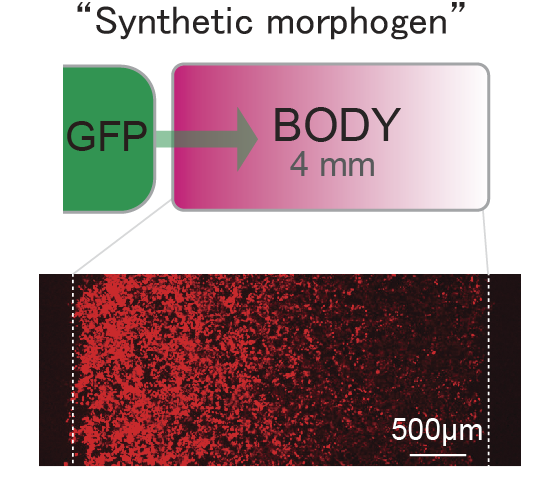Engineering biological pattern formation with synthetic morphogens
Abstract
Researchers at Kanazawa University report in Science how concentration gradients of particular molecules (‘synthetic morphogens’) can be produced in biological systems. Such gradients can be exploited for programming pattern formation, offering the promise of controlled tissue engineering.
Multicellular organisms can grow and develop thanks to so-called morphogens: molecules that provide positional information. They are produced in a source, from which they diffuse and build up a concentration gradient in their environment. Nearby cells can ‘read’ this gradient, therefore ‘know’ where they are in the organism and ‘act’ accordingly. Now, Satoshi Toda from Kanazawa University and colleagues report the successful engineering of a synthetic morphogen system that can be programmed. This achievement not only helps to understand how exactly morphogens encode positional information, but is also promising in the context of engineered tissue formation.
Toda who is a PI at the NanoLSI WPI at Kanazawa University, has in a few years become an expert on programming cell patterning and tissue self-assembly, and his team tackled the question of what a minimal synthetic morphogen signaling system looks like, with the synthetic system operating ‘orthogonally’ to biological (endogenous) morphogens, meaning that the endogenous and the synthetic system don’t interfere.
The researchers adapted an existing synthetic receptor system called synNotch so that it worked for soluble green fluorescent proteins (GFPs) as the morphogen molecules. (The original synNotch system requires morphogen molecules to be connected to a cell membrane, i.e. be non-soluble.) They did so by designing so-called anchor cells that can capture a GFP molecule in solution. An anchor cell carrying a trapped GFP molecule is then detected by a receiver cell (through chemical docking). Toda and colleagues demonstrated that this approach worked in vitro: a concentration gradient of GFP morphogen and activated cells formed within about 24 hours.
The scientists then investigated how the shape of the morphogen gradient can be regulated. They found that for different anchor protein densities, different gradient shapes were obtained. In addition, the spatial distribution of the gradient could be influenced through the use of inhibitors (molecules blocking the anchor–receiver mechanism). Toda and colleagues concluded that synthetic morphogen gradients can be tuned so that shapes similar to those occurring in vivo are obtained.
Finally, the research team around Toda showed that it is possible to alter the ‘interpretation’ of the gradient. They designed different kinds of feedback circuits, for example one in which GFP detection leads to more GFP production, or one in which GFP detection leads to GFP inhibitor production. Via such circuit engineering combined with the orphogenm and inhibitor sources, the scientists were able to produce binary and ternary domain structures.
The results of Toda and colleagues have promising application potential. Citing the researchers: “These synthetic morphogen platforms can program positional information without cross-talk to endogenous signaling pathways. Thus, it may be possible to deploy them in vivo as inert tools to probe or redirect [tissue] development.”

Figure:
Arbitrary proteins such as GFP can turn into a synthetic morphogen that forms a gradient pattern of gene expression.
Background
Morphogens
Morphogens are molecules that are essential for the biological process of pattern formation. They are produced in a source, after which they diffuse through surrounding tissue in an embryo, setting up concentration gradients in the process. These gradients then drive the biochemical reactions that ultimately lead to the formation of all the various tissues and organs in an organism. Kanazawa University’s Satoshi Toda, a pioneer of programming multicellular self-organizing structures, and colleagues have now shown that it is possible to design synthetic morphogen systems that have programming functionality but at the same time do not interfere with biological (non-synthetic) morphogen systems.
Green fluorescent protein
Green fluorescent protein (GFP) is a molecule displaying green fluorescence upon exposure to blue-to-ultraviolet light. GFP is often used in biomedical protein expression experiments. For instance, it has been shown that the GFP gene can be expressed in specific cells, particular organs, or whole organisms. Now, Toda and colleagues have shown that (soluble) GFP can be used as a synthetic morphogen.
Article
- Title
- Engineering synthetic morphogen systems that can program multicellular patterning, Science 370, 327-331 (2020).
- Author
- Satoshi Toda, Wesley L. McKeithan, Teemu J. Hakkinen, Pilar Lopez, Ophir D. Klein, and Wendell A. Lim.
- Journal
- Science
- Publication date
- Oct 15, 2020
- DOI
- 10.1126/science.abc0033
- URL
- https://science.sciencemag.org/content/370/6514/327

